German iris: varieties, planting and care

Flowering crops that are grown in front gardens and in city flower beds are presented in a wide variety. Among them, it is worth highlighting the German iris, notable for its wide varietal assortment and visual appeal.

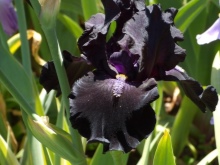

Description
Germanicus has several names. For example, in the circle of gardeners, the Germanic iris is sometimes called the violet root, the iris. The flower belongs to the Iris family, and is cultivated all over the world. The plant has a rather developed creeping root system with little branching, while the stem stands out for its power, grows straight without branches, can reach a height of 1 m. The green mass of iris stands out for its flat structure, has a xiphoid shape and pointed tips. The leaves are colored gray-green, while the concentration of green mass occurs below the peduncle itself, due to which the culture has an attractive fan on the stem of a color contrasting with the flower.
The flowers themselves are formed at the end of the stem: on a high bifurcated peduncle. Iris flowers are bisexual - as a rule, about 10 flowers can bloom on one plant. Each iris flower retains its freshness for 5-7 days, after which a new one blooms in its place. The active flowering phase occurs in May and June. The german iris develops fruits, which are represented by a small elongated box.



Varieties
Today, gardeners grow many different varieties of German iris. Among them, several types are popular.
"Black Dragon"
Flowers are presented in three colors, so iris can bloom with inflorescences of coal, blue and purple shades. Despite the relationship of these color variations to dark colors, this culture shimmers attractively in the sun, making it an adornment of any garden. Shoots elongate upwards by 80-90 cm, while the diameter of iris buds varies within 10-15 cm. In addition to the above features, the variety is notable for the presence of a unique aroma in the flowering phase.
This culture is for sophisticated gardeners, which attracts attention with an unusually exotic and beautiful color of black buds. This feature is in good harmony with the emerald green mass. On one shoot, as a rule, about 8-9 buds are formed, the petals of the flowers have a corrugated edge, which greatly increases their decorative attractiveness.

Sultan Palace
The flower is notable for the red-pink color of the petals, which together form a spectacular dome, while the outer petals have a curled edge, imitating an attractive beard. The flowers also give off a subtle and attractive scent during the flowering phase. The culture blooms in May, the flowering phase lasts for 14-16 days. The stem height reaches 50-60 cm.


Sia Double
Flowers of this variety reach 15 cm in diameter, while the stem itself can grow up to 1 m in height. The variety of a flowering culture belongs to the winter-hardy varieties, is unpretentious in care, therefore it is capable of flowering even in the partial shade of the garden. It blooms with blue inflorescences, decorated with a light blue beard.

Windsor Rose
The flowers of this variety are distinguished by some external resemblance to lilacs.The petals themselves are notable for a lavender-scarlet hue, they are also decorated with a tangerine-colored beard. The shoots of the flower reach a height of 80-85 cm, the diameter of the flowers varies between 12-16 cm.

"Purple Striped White"
The colors of the culture are notable for their tenderness, as well as some similarities between the peduncles and the orchid. The color of the petals of the flower is pale lilac, small strokes are allowed in the color of saturated shades. The variety reaches a height of 80-90 cm, however, the diameter of the flowers does not stand out for its impressive indicators, therefore it is about 5-8 cm.

Orange Harvest
It is a fiery, multi-flowered culture that enjoys well-deserved popularity due to its catchy coloration. The variety stands out among the other varieties of iris in the largest sizes, since the stem of the plant can reach 120 cm in height, single flowers develop at its ends.
Due to the structural features, it is usually planted together with other species of the group, however, in terms of neighborhood, this variety demonstrates some selectivity, which should be taken into account in the process of decorating flower beds.

Apache Warrior
An ornamental iris variety that blooms with golden inflorescences, shaded with red-brown blotches. The inflorescences do not exceed 9 cm in diameter, however, in the light of its color, it is such a culture that enjoys well-deserved popularity. The height of the iris stem reaches 100-150 cm.
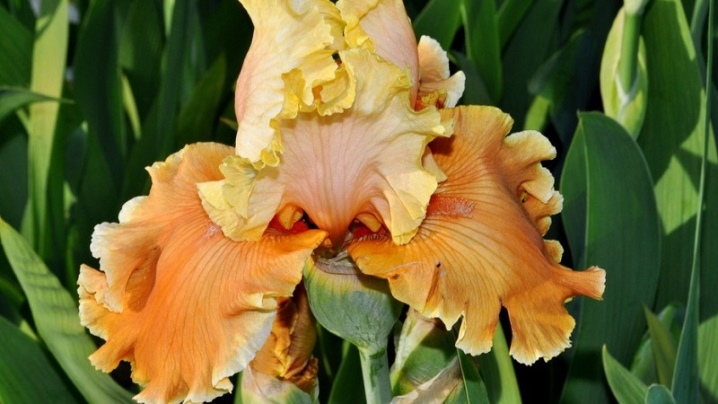
In addition to the above varieties of German iris, the following equally attractive garden crops are successfully grown by gardeners:
- "Bakwit";
- Beverly Siles;
- Bluebird Vine;
- "War Chief";
- Windree Sky;
- "Immortality";
- Pumpkin Cheesecake;
- Pink Horizon;
- Red Singer;
- Cimarron Strip;
- Sia Double;
- "Few Doo Sale";
- Honky Tonk Blues;
- Ever After;
- "Yakvina Blue".
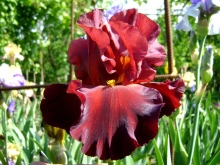


How to plant?
Planting germanica is carried out in open ground in early spring, but crops of this kind can also be successfully rooted throughout the summer, until autumn. Planting is usually done after the plant has finished flowering or before it begins. Iris german also requires certain preparatory measures before rooting in the garden. First of all, you should choose the best suitable place for growing flowering crops. The site must meet the following requirements:
- for most varieties, it is important that the flower bed is sufficiently lit;
- all varieties must be reliably protected from gusts of wind so that their stem, notable for its impressive height, does not break;
- there should be no stagnation of water in the soil, including it is desirable that groundwater does not lie close to the surface of the earth;
- it is best that the soil has good aeration - you need to take care of high-quality drainage in advance;
- the soil in the front garden with iris should be as nutritious as possible, with a high level of minerals.


Regardless of the chosen planting time, the area for the iris should be prepared in advance - it is better to do this in the spring. It is for this reason that compost and other top dressing useful for a flowering culture should first be introduced into the ground.
Potassium-phosphorus supplements should be a priority. It is also better to treat the soil with fungicides, which will eliminate the likelihood of damage to the root system by pathogenic viruses.


The landing algorithm looks like the one described below.
- Immediately before the rooting of the flower in the ground, the selected planting material must be treated with any growth stimulant. For plants that will be planted in open ground in the spring, such an event is mandatory.
- The next step is to shorten the length of the root system, as well as remove wilted, dry, or rotten areas. Pruning should be done with pre-decontaminated scissors or a sharp knife.
- Then you need to prepare the soil in the garden for planting.For these purposes, in the ground, you need to make a hole 20-25 cm deep.
- The rooting process itself involves placing the iris in the middle of the pit, after which the rhizome is sprinkled with soil, a small amount of river sand must be poured on top.
- When rooting several plants, a distance should be left between them, which should not be less than 50 cm.
- The final stage of iris planting will be watering. The first moistening in the new place should be abundant, however, liquid stagnation should be avoided.


The flower is able to actively develop and bloom in one place in the garden for 5-7 years, however, hybrid varieties are recommended to be transplanted once every 3-4 years. The transplant is carried out by analogy with the landing scheme described above.
Before changing the place of growth, the root system must be kept for 10-15 minutes in potassium permanganate. During this period, reproduction can be carried out by division.
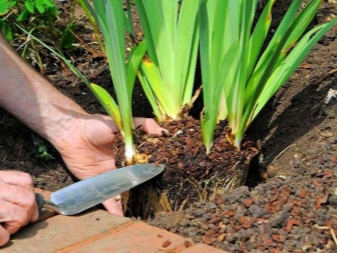

How to take care of it properly?
Caring for a culture comes down to performing some activities.
Watering
Since the iris grows quite actively, it will need a lot of liquid for proper development and timely flowering. This is especially true of the adaptation period, which lasts for several weeks after rooting. In loam or sandy loam soil, it is recommended to moisten the iris every evening; in the daytime, moisture from the soil evaporates several times faster, which negatively affects the development of the flower. After each introduction of moisture, it is necessary to loosen the soil.

Top dressing
The introduction of fertilizers should be regular. For the first time, such a procedure is performed in early spring. For this it is necessary to water the soil with top dressing based on superphosphate and potassium sulphide... It is better to do this during the summer - you need to do at least three such dressings. In the phase of active foliage growth, nitrogen can be used, as well as supplementary feeding based on phosphorus and potassium.


Post-flowering care
When the peduncles wither, they must be removed without fail. This should be done with processed garden shears.
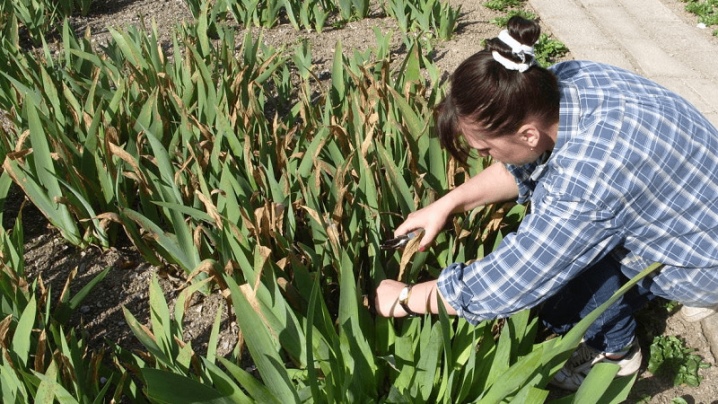
Preparation for wintering
Frost-resistant varieties are able to overwinter in the ground, but their root system needs additional shelter, which can protect it from freezing. For these purposes, the gardener needs to mulch the soil around the iris.
Spruce branches, needles, sawdust or other suitable materials can be used as a covering material.


Reproduction methods
Even a novice gardener will be able to propagate German iris. A new plant can be obtained in several ways.
Seed reproduction
This method will be productive only for wild species of flowering crops, since hybrid varieties in this version may lose their unique characteristics. To get a new flower, you need to collect or purchase seed material, sow it in the soil in the fall. During the winter, the planting material will undergo natural stratification, as a result of which the most resistant seeds will sprout with the arrival of heat.
If you plan to plant the material in the spring, then before deepening the seeds into the ground, you will need to artificially harden the planting material. For these purposes, sand is used, in which the seeds are stored in the refrigerator for 1-2 months, after which they are sown in open ground.


Dividing the bush
This is the most successful option, guaranteeing a new flowering crop in a short time. The main positive feature of this method is the ability to preserve all varietal characteristics of the plant, including hybrid crops.
To divide the mother culture, it should be watered abundantly, then removed from the soil, and the remnants of the earth removed from the rhizome. A part with a root system and a bunch of leaves will act as a full-fledged planting material.After dividing, the cut site on all crops is treated with a solution of potassium permanganate, the plants are dried, the foliage and rhizome are shortened by a quarter.
The new culture will be suitable for planting immediately, but it will be successfully rooted within two weeks.
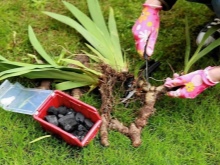


Diseases and pests
Iris is characterized by lesions by some ailments.
- Root rot. This is the most dangerous disease, as a result of which rhizome decay occurs. At the first signs of wilting, the plant must be removed from the soil, removed the affected areas, treated with a fungicide, and also disinfected the soil.
- Heterosporia. Signs of the development of such a disease are brown spots on the green mass. When they appear, the gardener needs to remove the affected areas, carry out preventive treatment of the flower with copper sulfate.


Among the insect pests that pose a danger to iris, it is worth noting thrips and slugs.
- Thrips. If a pest is found on a flower, it is necessary to spray the culture with a fungicide.
- Slugs. Such pests can attack the flower during the period of heavy rains. They are usually removed manually, supplementing the measures with the treatment of iris with superphosphate, which must be injected directly into the soil.


Examples in landscape design
- Many gardeners prefer to plant iris in a stone garden, complementing the composition with small flowering neighboring crops, which can be dwarf carnations or cornflowers of contrasting shades.

- On flower beds, irises are in perfect harmony with lilies, daisies or campanula. At the same time, the compositions can have strict geometric lines or be shaped like a chaotic planting of crops, which will look no less attractive.

- Iridariums can be arranged along rocky paths in the garden or in a public recreation area. Flowers will not only decorate the landscape design, but also exude a pleasant aroma.

In the next video, you will find a step-by-step master class on transplanting irises.







































































































The comment was sent successfully.